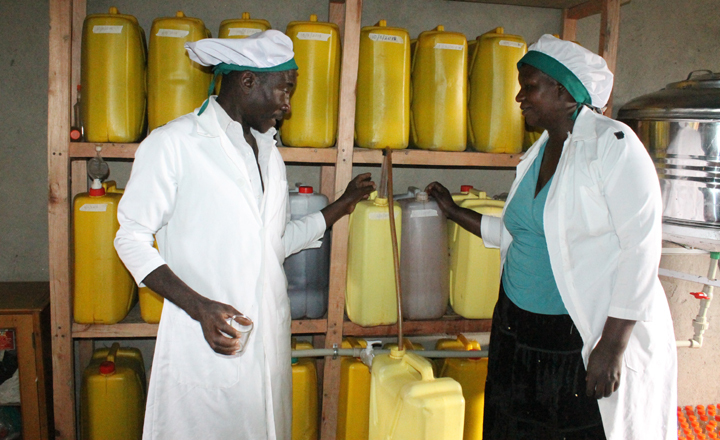How to add value to bananas
A 20kg bunch of bananas can produce at least 10 litres of diluted juice
At the peak of every banana harvesting season like today, farmers lament about a drop in prices due to the pumper harvests.
In some areas for example Isingiro, Ntungamo, Bushenyi and Bunyaruguru, prices drop to as low as sh3,000 for each bunch. However, if farmers can add value to their bananas, profit from their produce would go up.
How to make banana juice
What you need
- Bananas, a bunch of 60kgs costs sh10,000
- Banana juice press costs from sh250,000 for a small one
- A pasteurizing system at a cost of sh1-2m for small enterprises
- Clean water and jerrycans
- Packaging materials at sh500 for each half litre
For a long time, banana juice was mainly got from Kisubi, Kayinja and Musa varieties. Ideally, these should still produce the best juice. However, they are getting scarce. This is why most processors now use common bananas.
The best juice is made from the best bananas. They should not have any scratches and must be mature before they are harvested. Keep them in a warm place for them to ripen. After ripening up, they are pressed/squeezed, using a fruit press if you have one or by hand if a person does not have the press.
Juice presses of any sizes are sold in domestic utensils stores around town from sh200,000. If you are pressing by hand, you use clean straw or half-dried banana leaves to help you squeeze the juice out of the bananas. The juice is diluted according to the required taste. For a good taste, one litre of banana juice is diluted with 4 litres of water.
The juice is then boiled and then mixed with a preservative. Beverage preservatives are elements that stop bacterial reactions that cause rotting in foods. Packaging materials are sold in plastics dealers stores around Kampala at as low as sh500 for a half litre bottle.
A 20kg bunch of bananas can produce at least 10 litres of diluted juice. A packed litre of banana juice costs sh6,000-7,000 in most supermarkets.
Banana winemaking procedure
Requirements
- Bananas
- Clean saucepans and jerrycans (depends on volume)
- Bottles for packaging the wine-sh2500 each
According to Professor George William Bazirake Byarugaba of Afri-banana, an organization that trains people to add value to bananas, you, first of all, get ripened bananas and peel them, you extract juice and pasteurize, then add yeast and afterwords ferment to complete. The process takes 3-4months.

Equipment used for small scale wine processing includes clean saucepans and jerrycans. In addition to that filter and bottle the product. When you are through, you can seal the bottle and label it.
Also, allow the wine to mature further and when it is done, you can distribute it to the users. Lastly, allow the wine to mature further and then distribute it to the users. A litre of banana wine costs over sh25,000 onwards.
Bazirake says that Afri-banana holds incubator training for people willing to add value to bananas.
Processing banana flour
The Presidential Initiative on Banana Development (PIBID) has got the most ambitious project of processing flour from bananas, with their Tooke brand of products.
According to Dr Florence Muranga, PIBID is now in final plans of commercializing the flour and other products, at their plant in Bushenyi. This she says will help take off large tons of bananas from the market.
Charles Kitamirike, the extension officer in charge of community processing units at PIBID, said at full capacity the factory consumes 10 tonnes of fresh bananas.
Kitamirike said 10 kilogramme of fresh bananas produces about 1kg of banana flour when dried and processed. "The bananas are taken through an elaborate drying process before the flour is finally packed," Kitamirike says.
The factory buys banana from farmers in kilograms through the cooperatives at sh460 per 1kg which according to him is a better price than prevailing open market prices.
Since the average weight of a bunch is 40kgs, this means that the farmer gets around sh10,000 per bunch. In an area where prices average sh5,000, the farmer certainly makes more money.
The flour can be used as food-directly or as a base for the processing of confectionaries like cakes.
Art & crafts
The banana fibre perhaps provides more versatility, especially because it is used to create a big array of art and crafts. Doreen Nitusiima, CEO of Afri -Jewelry and a resident of Kireka is one of the beneficiaries of Afri-banana.
Nitusiima says the company deals in making handmade crafts such as banana paper beads, bead handbags, necklaces, bangle among others. Unlike other products for example juice, making artifacts from banana fibres requires a degree of skill.
"I have received support in form of skills and marketing from Afri-banana that has enabled my business to go forward," she says. Nitusiima has been able to create jobs for women groups that make the beads and two other people she employs directly. She gets her raw materials from farmers across western Uganda.
Trisha Nalumansi also adds value to banana fibres, Nalumansi crafts things like money purses, small handbags and clocks from banana fibres. "We pick the best, straight dried fibres and then we turn them into artifacts," she says. The products are then sold in shorps around town. Prices of the clocks vary from sh50,000, while bags and money purses can be got at as low as sh15,000.
Other by-products like the peelings are used as feeds for livestock, while the leaves are mainly used to wrap food during cooking and as feeds too for livestock. Peels are either fed to the animals fresh or dried and mixed with processed feeds.